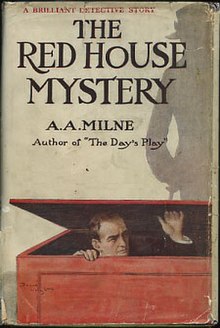The Red House Mystery

First edition
|
|
| Author | A. A. Milne |
|---|---|
| Cover artist | Frank Wright |
| Country | United Kingdom |
| Language | English |
| Genre | Mystery novel |
| Publisher | Methuen (UK) & E.P. Dutton (USA) |
|
Publication date
|
6 April 1922 |
| Media type | Print (hardback & paperback) |
The Red House Mystery is a "locked room" whodunnit by A. A. Milne, published in 1922. It was Milne's only mystery novel.
The setting is an English country house, where Mark Ablett has been entertaining a house party consisting of a widow and her marriageable daughter, a retired major, a wilful actress, and Bill Beverley, a young man about town. Mark's long-lost brother Robert, the black sheep of the family, arrives from Australia and shortly thereafter is found dead, shot through the head. Mark Ablett has disappeared, so Tony Gillingham, a stranger who has just arrived to call on his friend Bill, decides to investigate. Gillingham plays Sherlock Holmes to his younger counterpart's Doctor Watson; they progress almost playfully through the novel while the clues mount up and the theories abound.
The Red House Mystery was immediately popular; Alexander Woollcott called it "one of the three best mystery stories of all time", though Raymond Chandler, in his essay The Simple Art of Murder (1944), criticised Woollcott for that claim, referring to him as, "rather a fast man with a superlative". Chandler wrote of Milne's novel, "It is an agreeable book, light, amusing in the Punch style, written with a deceptive smoothness that is not as easy as it looks [...] Yet, however light in texture the story may be, it is offered as a problem of logic and deduction. If it is not that, it is nothing at all. There is nothing else for it to be. If the situation is false, you cannot even accept it as a light novel, for there is no story for the light novel to be about."
In his introduction to the 1926 UK edition, A. A. Milne said he had "a passion" for detective stories, having "all sorts of curious preferences" about them: though in real life the best detectives and criminals are professionals, Milne demanded that the detective be an unscientific amateur, accompanied by a likeable Watson, rubbing shoulders with an amateur villain against whom dossiers and fingerprints are of no avail.
Chandler's essay rejects this model, declaring: "It is the ladies and gentlemen of what Mr. Howard Haycraft (in his book Murder for Pleasure) calls the Golden Age of Detective Fiction that really get me down." He uses The Red House Mystery to illustrate the problems he saw in many mystery stories of this type, particularly the central puzzle (which was intricate and clever but implausible in many ways) and the fact that the amateur detective's chance to shine comes only because the police are incompetent and surprisingly willing to put up with a "brash amateur" romping through their territory. ("English police seem to endure him with their customary stoicism; but I shudder to think of what the boys down at the Homicide Bureau in my city would do to him.")
...
Wikipedia
